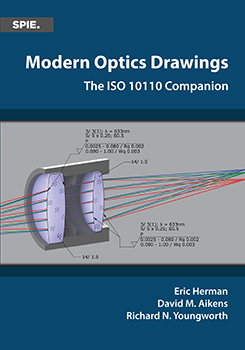|
Surface roughness tolerances are requirements for the level of smoothness of the polish of an optical surface, typically expressed as a maximum allowed RMS surface height error and evaluated with a profilometer. The advent of highly deterministic small-tool polishing has led to increased importance of spatial frequencies lower than traditional roughness scale-lengths but higher than those more easily controlled using surface form tolerances described in Chapter 3. To cover this need, the standard includes notation to control such mid-spatial frequency errors with more rigor. ISO 10110-8 provides the notations for a variety of tolerancing methods of varying complexity and sophistication. The simplest form of surface texture tolerance is a simple polishing grade based on a standard level of RMS roughness. If the standard polish grades are not suitable, any level of RMS roughness tolerance can be defined. Moreover, the scale-lengths over which the RMS roughness requirement is to be evaluated can be customized. This same tolerance methodology can be used to specify deliberately rough surfaces, such as the ground edge of a lens, using both upper and lower bounds on the roughness. In addition to these fairly conventional notations, the standard provides for more complex tolerances often used to control midspatial frequency surface form errors, or waviness, based on peak slope, RMS slope, and even a power spectral density (PSD). The most recent edition of the standard adds the areal (2D) versions of these notations. |
|
|


